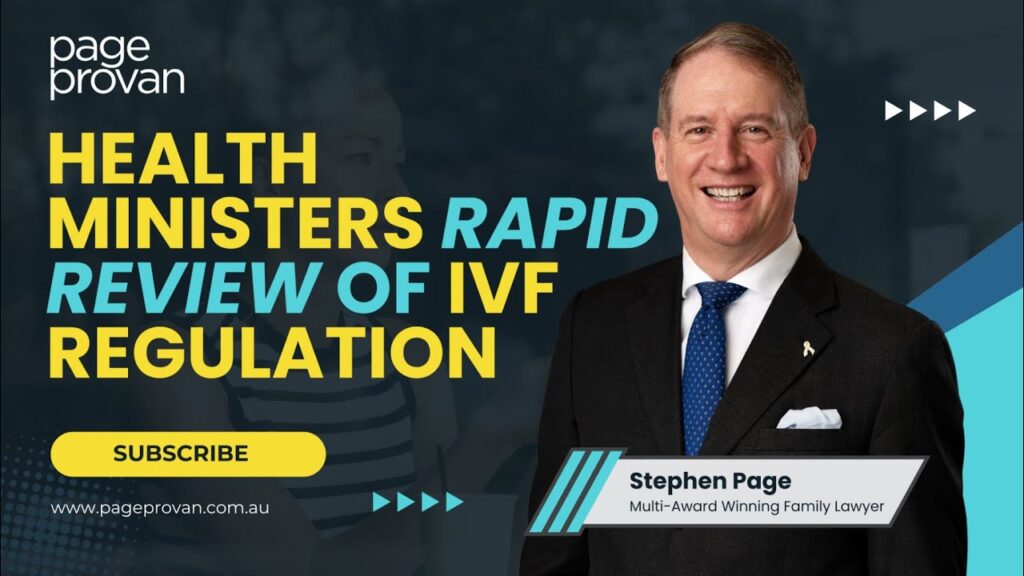Should the genetic dad be named on the birth certificate as the father before an order is made?
I am very much a believer in getting it right first time. One of my cardinal rules with surrogacy cases is that I hate surprises- or to put it another way, prevention is better than cure. I aim to make my clients’ surrogacy journeys as quick, as cheap and above all as stress free as possible.
When it comes to naming the father on the birth certificate when the child is born, I follow the law- which in Australia is (usually) that the surrogate’s husband is the father.
A question I have been asked from time to time is should the genetic father should be named on the birth certificate as the father before a domestic surrogacy order is made? It has been raised with me a couple of times in the last couple of weeks, so I thought it a good idea to set the record straight.
The simple answer is: NO. There are a number of reasons for this, but the basic one is this:
Who is the genetic parent may not be the same as the legal parent.
I’ll give an example, say of a New South Wales surrogacy arrangement, where there is a gay couple who are the intended parents, with a married surrogate. One of the gay couple is the genetic father of the child.
Who is the father of the child at birth?
The point of a parentage order is to transfer parentage from the birth parents to the intended parents. Who then are the intended parents at birth?The answer is contained in the Status of Children Act 1996 (NSW), section 14:
1) When a married woman has undergone a fertilisation procedure as a result of which she becomes pregnant:
(a) her husband is presumed to be the father of any child born as a result of the pregnancy even if he did not provide any or all of the sperm used in the procedure, but only if he consented to the procedure, and
(b) the woman is presumed to be the mother of any child born as a result of the pregnancy even if she did not provide the ovum used in the procedure.
(2) If a woman (whether married or unmarried) becomes pregnant by means of a fertilisation procedure using any sperm obtained from a man who is not her husband, that man is presumed not to be the father of any child born as a result of the pregnancy.
(4) Any presumption arising under subsections (1)-(3) is irrebuttable.
So there it is- the genetic father is not the legal parent at birth- the surrogate’s husband is the parent.
In seeking a parentage order, s.38 of the Surrogacy Act 2010 requires that the child’s birth be registered in accordance with the Births, Deaths and Marriages Act 1995.
The offence
In light of that statutory presumption, the intended father should not be registered as the father on the birth certificate, because to do so is a criminal offence. This is because of section 57 of the Births, Deaths and Marriages Registration Act 1995 (NSW):
Maximum penalty: 100 penalty units or 2 years imprisonment, or both.
The caselaw:“at their peril”
While it is possible to have a parentage order made in New South Wales when the intended father was named on the birth certificate at birth as the father, judges have been highly critical of the practice.
For example, see BB v DD [2015] , where the judge said the next time it was heard in BB v DD (No 2) [2015] said that those who ignored s.38 of the Surrogacy Act did so “at their peril”.
The earlier case of S v B; O v D [2014] involved a gay couple who were the intended parents, and a married surrogate. In the words of Justice White:
- It follows that the naming of the intended father as the child’s father on the birth certificate did not give him the status of father(Re A and B [2000] NSWSC 640; (2000) 26 Fam LR 317 at [40]). It also follows that the wrong person was named as father on the birth certificate. The birth was not registered in accordance with the requirements of the Births, Deaths and Marriages Registration Act 1995 (NSW) as required by s 38 of the Surrogacy Act.
…
- A difficulty in both cases was that the husband of the birth/surrogate mother was not prepared to complete a birth registration statement that named him as the father of the child, notwithstanding that until a parentage order were made under the Surrogacy Act (or an adoption order made if that were required), he was irrebuttably presumed to be the child’s father.
- The solicitor for the plaintiffs advised that she provided legal advice to the parties that the birth mother (that is, the surrogate mother) should be recorded on the birth certificate as the child’s mother and that the intended father should be named on the birth certificate as the child’s father. She advised that in both cases the husband of the birth mother did not wish to be named on the birth certificate as the child’s father. She stated:
“As the husband of the surrogate mother did not wish to be recorded on the birth certificate, as there was the intention by the plaintiffs to apply for a parentage order with the consent of the defendants and as there was no penalty for registering the second plaintiff as father, or no specific exclusion not to be registered, the advice given by me was for the second plaintiff to be recorded on the birth certificate as father. (In each case the second plaintiff was the intended father.)”
- The solicitor for the plaintiffs submitted that it was in the best interests of each child from the outset that the intending fathers be registered as the children’s fathers. Having their name on the birth certificate as father assisted in the process of having the child’s name on the Medicare card of the intending father soon after the birth of the child. The children lived with their intended parents very soon after birth. If there had been any post-birth complications for which a father’s consent to medical treatment might have been required, having the intended father’s name on the birth certificate could have avoided complications.
- In one of the cases the solicitor advised that following the birth of the child the surrogate mother and her partner separated and remain separated and the partner of the surrogate mother initially refused to sign a consent to the application for the parentage order, although it was always the intention and agreement of the parties that the intending father would become the father of the child and the partner of the surrogate mother would never act as the father of the child.
- Hence, recording the intending father as the child’s father on the birth certificate reflected the physical realities of the situation.
- The pre-condition in s 38 to the making of a parentage order is not met. Despite that pre-condition not having been met, the parentage order can be made if I am satisfied that exceptional circumstances justify the making of the order (Surrogacy Act, s 18). The guiding principle in administering the Act is that the best interests of the child be paramount (s 3). The phrase “exceptional circumstances” is used in a wide variety of legislation. The phrase is to be construed in the context in which it appears and having regard to the purposes of the legislation. In its ordinary sense circumstances can be exceptional if they are out of the ordinary. …
- I am satisfied in the present case that there are exceptional circumstances that justify ignoring the non-satisfaction of the pre-condition in s 38. I think it must be unusual and out of the ordinary for parties to be advised by a solicitor that they need not comply with the requirements of the law. That is what the solicitor’s advice amounted to in this case. No doubt the advice was well-meaning, but it was wrong.
- The solicitor said that it was intended that the plaintiffs (the intended parents) would apply for a parentage order with the defendants’ (the surrogate mother and her husband) consent. But the application initially made was only for the transfer of the mother’s parentage. If that had been the only order made the child would be without a father. The incorrect details on the birth certificate would not withstand scrutiny if the child’s parentage were in issue. I infer that the reason that the intended fathers in the present case did not initially seek a parentage order for the transfer of the parentage of the children from the partners of the surrogate/birth mothers to them was that they considered that having been recorded on the birth certificate as the children’s fathers, they would have that status and nothing more would need to be done. Whilst their registration as the children’s fathers gave rise to a presumption that they had that status, the presumption could readily be rebutted with potentially irreversible consequences, for example, if one of the intended fathers died and the question was whether his estate should pass to his child on intestacy.(emphasis added)












